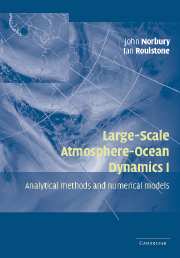Book contents
- Frontmatter
- Contents
- Contributors
- Preface
- Introduction and Scientific Background
- 1 A view of the equations of meteorological dynamics and various approximations
- 2 Extended-geostrophic Euler–Poincaré models for mesoscale oceanographic flow
- 3 Fast singular oscillating limits of stably-stratified 3D Euler and Navier–Stokes equations and ageostrophic wave fronts
- 4 New mathematical developments in atmosphere and ocean dynamics, and their application to computer simulations
- 5 Rearrangements of functions with applications to meteorology and ideal fluid flow
- 6 Statistical methods in atmospheric dynamics: probability metrics and discrepancy measures as a means of defining balance
2 - Extended-geostrophic Euler–Poincaré models for mesoscale oceanographic flow
Published online by Cambridge University Press: 04 February 2010
- Frontmatter
- Contents
- Contributors
- Preface
- Introduction and Scientific Background
- 1 A view of the equations of meteorological dynamics and various approximations
- 2 Extended-geostrophic Euler–Poincaré models for mesoscale oceanographic flow
- 3 Fast singular oscillating limits of stably-stratified 3D Euler and Navier–Stokes equations and ageostrophic wave fronts
- 4 New mathematical developments in atmosphere and ocean dynamics, and their application to computer simulations
- 5 Rearrangements of functions with applications to meteorology and ideal fluid flow
- 6 Statistical methods in atmospheric dynamics: probability metrics and discrepancy measures as a means of defining balance
Summary
Introduction
We continue the study of intermediate models (McWilliams and Gent, 1980) for possible application to mesoscale oceanographic flow fields. Intermediate models are derived under the assumption that the Rossby number ∈ is small and filter out high-frequency gravity-inertial waves. Previous work has involved intermediate models for flows of homogeneous fluids governed by the f-plane shallow water equations (SWE) (Allen et al., 1990a,b; Barth et al., 1990; Allen and Holm, 1996) and for flows of continuously stratified fluids governed by the hydrostatic primitive equations (PE) (Allen, 1991; Allen, 1993; Allen and Newberger, 1993; Holm, 1996).
We use a traditional modelling approach of making approximations in Hamilton's principle. This approach was developed for geophysical fluid dynamics (GFD) and applied by Salmon (1983, 1985, 1996) to construct approximate balanced equations by substituting leading order balance relations and asymptotic expansions into Hamilton's principle before taking variations (see also Allen and Holm, 1996, and Holm, 1996). In the present paper, we use this approach to derive approximate intermediate models for mesoscale oceanographic flow. For this, we work in the framework of the Euler–Poincaré theorem for ideal continua with advected parameters (Holm, Marsden and Ratiu, 1998a). Euler–Poincaré systems are the Lagrangian analogue of Lie–Poisson Hamiltonian systems (Holm, Marsden, Ratiu, and Weinstein, 1985, and references therein). In this framework, the resulting Eulerian approximate GFD equations possess a Kelvin–Noether circulation theorem, conserve potential vorticity on fluid particles and conserve volume integrated energy. In addition, following the derivations we assess the accuracy of the model equations through numerical experiments.
- Type
- Chapter
- Information
- Large-Scale Atmosphere-Ocean DynamicsAnalytical Methods and Numerical Models, pp. 101 - 125Publisher: Cambridge University PressPrint publication year: 2002
- 7
- Cited by



